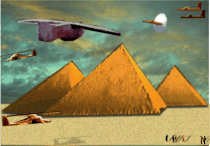Dinosaurs in Art: A Han Dynasty Flat Headed (Hadrosaurine)Dinosaur? ...Page 38

This piece is a replica of a Han Dynasty, bronze cooking vessel. The Han Dynasty spanned the period of between approximately 200 B.C. to 220 A.D..
Click and drag photo to resize.


Description
"Chinese Bronze has long been considered a treasure from ancient China. Dating back to 4000 years ago, Chinese bronze were not only the daily utensils, work tools and weapons of the people of ancient times, but also exquisite works of master craftsmen, which have been handed down from generation to generation.
The study of Chinese bronze usually spans an extensive period of time, up to the end of the Han Dynasty (220 AD).
Excavation during the early to mid 1950s in the People's Republic of China had discovered many pieces of treasures that are now in the exhibition of Beijing History Museum, Shanghai Museum and the ShannXi History Museum.
Click and drag photo to resize.

Since ancient Chinese bronze pieces are fetching millions of dollars in auction houses and many are considered national treasures, genuine pieces are difficult to obtain. In the last thirty to forty years, Quality reproduction Chinese bronzes have been made primarily for the museum goers."www.Shanghai30.com
To our eyes, this piece features one of the hadrosaurine dinosaurs, also known as flat headed dinosaurs-complete with reptilian skin. Alternate descriptions or explanations of the creature could include "seals", "dragon" or "mythical animal".
Many of the Hadrosaurs were very similar in appearance, including edmontosaurus, hadrosaurus and even the supposedly related iguanadon. However, we have settled on Shantungosaurus, primarily because of similar looking artist representations based on its skull and because it has been found in China. Keep in mind that these dinosaurs were supposedly extinct 90 million years ago.
Left to right:shantungosaurus, Han Dynasty animal, iguanadon and another shantungosaurus. Click and drag photo to resize.


It seems clear to us however, that a skilled artisan had seen them in life. So common they must have been that he did not find it necessary to include the entire animal in his/her portrait-confident perhaps that those who would see the piece were very familiar with its subject....s8int.com

Shantungosaurus
DESCRIBER Hu,1973
TIME Cretaceous Late
CLASSIFICATION Ornithischia Ornithopoda Hadrosauridae Hadrosaurinae Edmontosaurini
DIET Herbivore
FOSSILSITE China
TYPE SPECIES SHANTUNGOSAURUS giganteus
LENGTH 15 meter
Source: DinoData

HADROSAURIDAE
"Hadrosaurids (meaning "bulky lizards") were the family of duck-billed, herbivorous dinosaurs. They were the most common dinosaurs. Hadrosaurs ranged in size from 10 to 40 feet (3 to 12 m) long.
They had horny, toothless beaks and hundreds of cheek teeth in the sides of their jaws. The duck-billed dinosaurs had the most teeth; they had up to about 960 cheek teeth.
Hadrosaurs had a stiff tail that was probably used for balance. They had hoof-like nails on their feet, and bumpy skin. They ran on two legs, holding their tail and head in a horizontal position.
They may have walked on all four legs while grazing. Hadrosaurs probably lived near bodies of water, migrating to high ground to lay eggs. It used to be thought that thay had webbed hands, but this was an artifact of the fossilization process.

Photo: Han Dynasty animal with edmontosaurus skull.
Hadrosaurs are closely related to the Iguanodontids, and are probably their descendants. Hadrosaurs were Ornithischians (the order of bird-hipped dinosaurs) and Ornithopods ("bird-footed" herbivores with hoof-like feet). Hadrosaurs are divided into two groups, the Hadrodsaurinae (non-crested hadrosaurs) and the Lambeosaurinae (hadrosaurs that had skull crests that connected with their nasal passages).
Hadrosaurs lived during the late Cretaceous period. Their fossils have been found in North America, Europe, and Asia"....Enchanted Learning

1, 2, 3, 4, 5, 6, 7, 8, 9, 10
11, 12, 13, 14, 15, 16
17 18, 19,
20,
21,
22,
23,
24,
25,
26,
27,
28,
29,
30,
31,
32,
33,
34,
35,
36,
37,
38,
39,
40,
41,
42,
43,
44,
45,
46,
47
Next>>>


 Home
Home 20th Century Dinosaurs
20th Century Dinosaurs Dinosaurs in Literature, Art & History
Dinosaurs in Literature, Art & History Eyewitness Accounts
Eyewitness Accounts There Were Giants In The Earth in Those Days
There Were Giants In The Earth in Those Days Mega Fauna
Mega Fauna Those Sophisticated "Cave Men"
Those Sophisticated "Cave Men" Search for Noah's Ark
Search for Noah's Ark DNA, The Ultimate Oopart
DNA, The Ultimate Oopart The Bone Yards
The Bone Yards Underwater Cities, Monuments?
Underwater Cities, Monuments? Ancient Atomic Knowledge?
Ancient Atomic Knowledge? Salvation. What Must You Do To Be Saved?
Salvation. What Must You Do To Be Saved? Search
Search Links
Links Guestbook
Guestbook



